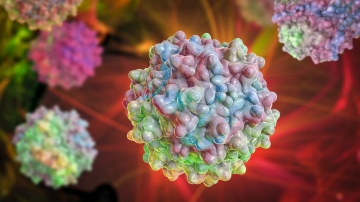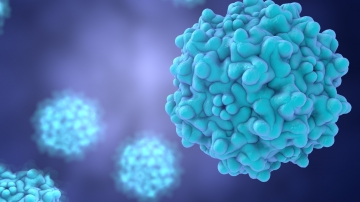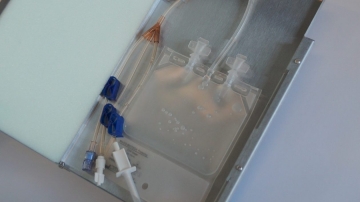Non-viral vectors vs. viral vectors in gene therapy
Table of contents
ShowWhen designing gene therapies, the choice between non-viral and viral vectors plays an important role in determining the success and safety of therapeutic interventions. Non-viral vectors offer unique advantages, while viral vectors have their own set of strengths and weaknesses. Understanding the differences between these approaches is essential for both researchers and clinicians seeking to harness the power of gene therapy for various medical conditions.
In this blog post, we will explore the types, benefits, and limitations of both non-viral and viral vectors in gene therapy.
Non-viral vectors in gene therapy
The use of non-viral vectors in gene therapy is an area of intense research. And indeed, there has been great success in recent years, with several non-viral vectors being approved.
Types of non-viral vectors
Non-viral vectors encompass a spectrum of approaches, each with its unique characteristics and applications:
Chemical-based vectors
Chemical-based vectors utilize synthetic or naturally occurring compounds to facilitate gene delivery. Notable examples include:
- Liposomes: These are small lipid-based vesicles that encapsulate and transport genetic material into cells. Liposomes offer versatility and are relatively well-tolerated by the immune system.
- Polymers: Synthetic polymers like polyethylenimine (PEI) and polyethylene glycol (PEG) can form complexes with DNA or RNA for delivery.
- Nanoparticles: Tiny particles can transport genes into cells. Their small size facilitates efficient uptake by target cells. LNPs (lipid nanoparticles) are being intensely investigated as a promising type of non-viral vector.
Physical methods
Physical methods harness forces such as electricity or sound waves to facilitate gene delivery:
- Electroporation: This technique involves applying brief electrical pulses to create temporary pores in cell membranes, enabling genes to enter. Electroporation is versatile and suitable for a wide range of cell types.
- Sonoporation: Ultrasound waves induce temporary openings in cell membranes, allowing for gene delivery.
- Gene Gun: Gene guns propel particles coated with DNA at high speeds, enabling them to penetrate cell membranes. This method is particularly effective for delivering genes to target tissues.
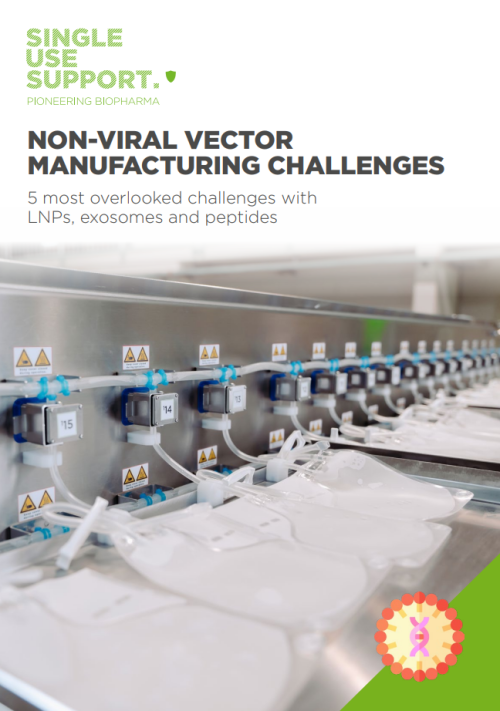
Download Guide
Download: Non-viral vector manufacturing - 5 overlooked challenges
Navigate the most overlooked challenges in non-viral vector manufacturing. Our guide covers topics like degradation and instability of LNP during freezing, scalability concerns in exosome manufacturing, homogenization of plasmid DNA in liquid transfer and much more.
Pros and cons of non-viral vectors in gene therapy
Non-viral vectors offer several advantages and disadvantages in the context of gene therapy:
Advantages
- Safety is a notable asset of non-viral vectors. They are generally regarded as safer than viral vectors, posing a lower risk of triggering an immune response, as well as bringing lower cytotoxicity and mutagenesis.
- Versatility is another key strength. Non-viral vectors can transport a wide range of genetic cargo, including plasmid DNA, mRNA, and small interfering RNA (siRNA).
- Additionally, non-viral vectors reduce the risk of unintended genetic alterations, a concern associated with certain viral vectors.
- One major advantage of non-viral vectors is their potential to lower production costs and facilitate the manufacturing of therapies at a larger scale, in that there is no need to generate large amounts of biomass, which is a challenge in the production of virus-based products.
Disadvantages
- Non-viral vectors tend to achieve lower rates of gene delivery compared to select viral vectors. This lower transfection efficiency may limit their effectiveness in some applications.
- Moreover, non-viral vectors typically result in transient gene expression, necessitating repeated treatments for sustained therapeutic effects.
- Lastly, these vectors may encounter challenges when dealing with specific cell types, which can restrict their use in certain gene therapy applications.
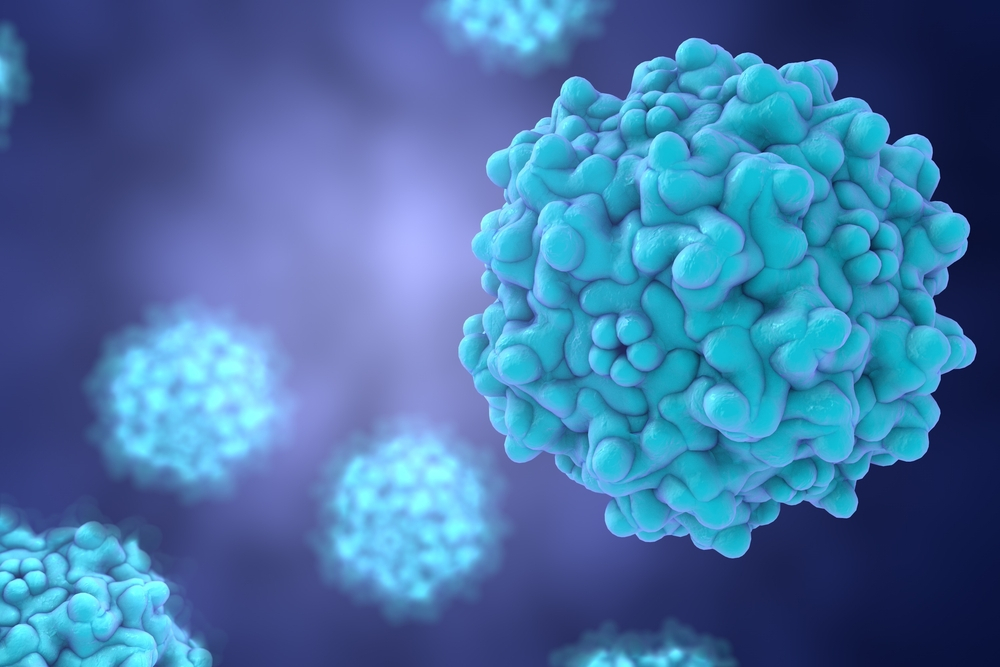
Viral vectors in gene therapy
Viral vectors, derived from naturally occurring viruses, have unique features that make them both effective and, at times, challenging in the context of gene therapy. So what are the types, advantages, and limitations of these vectors in the pursuit of innovative medical treatments?
Types of viral vectors
Viral vectors used in gene therapy are derived from different types of viruses, each with different characteristics:
- Adenoviruses – Adenoviruses efficiently deliver genetic material to various cell types. They are commonly used for transient gene expression.
- Adeno-associated viruses (AAV) – These vectors offer stable gene expression without integrating into the host genome, making them suitable for various therapeutic applications.
- Lentiviruses – Lentiviruses, a subgroup of retroviruses, can integrate genes into the host cell's genome, providing long-lasting gene expression.
Pros and cons of viral vectors in gene therapy
Viral vectors offer unique advantages and disadvantages for gene therapy:
Advantages
Viral vectors are known for their high transduction efficiency, ensuring effective gene transfer to target cells. This efficiency is a key advantage in achieving therapeutic outcomes.
Another significant advantage lies in the potential for long-lasting gene expression. Certain viral vectors, such as lentiviral vectors, can integrate their genetic cargo into the host genome, providing sustained therapeutic effects.
Moreover, viral vectors are highly adaptable and can be tailored for specific cell types, tissues, or diseases, offering a high degree of versatility.
Disadvantages
Viral vectors can be immunogenic, potentially triggering an immune response in the host. This immune response may limit their efficacy and raise safety concerns in some cases.
Additionally, the complex manufacturing and purification processes associated with viral vectors can be both complex and costly, posing challenges, especially when scaling up production for large-scale therapeutic applications.3
Non-viral vs. viral vectors – similarities and differences in an overview
When it comes to gene therapy, the choice between non-viral and viral vectors is a critical consideration, each with its unique attributes and applications.
| Aspect | Non-viral Vectors | Viral Vectors |
| Origin | Synthetic or naturally occurring compounds | Derived from naturally occurring viruses |
| Gene Delivery Mechanism | Complexation or physical methods (e.g., electroporation, sonoporation) | Infection and hijacking of host cells |
| Safety | Generally considered safer with lower immunogenicity | Generally considered safe; may trigger immune responses and safety concerns |
| Transfection Efficiency | Typically lower, requiring optimization for effectiveness | Often higher, ensuring efficient gene transfer |
| Duration of Gene Expression | Transient, necessitating repeated treatments | May be transient (e.g., adenoviruses) or long-lasting (e.g., lentiviruses) |
| Integration into Host Genome | Does not integrate into the host genome, reducing the risk of mutations | Some vectors (e.g., lentiviruses) can integrate, potentially raising safety concerns |
| Vector Complexity | Generally simpler to design and produce | More complex manufacturing and purification processes |
| Applications | Versatile for a wide range of genetic cargo and cell types | Tailored for specific cell types, tissues, or diseases |
| Immunogenicity | Lower immunogenicity, making them well-tolerated | May provoke an immune response in the host |
| Therapeutic Use | Suitable for short-term interventions and transient gene expression | Used when sustained gene expression is required |
Despite the differences between viral and non-viral vectors, there is one key-similarity that concerns manufacturers of both vector types alike: the necessity of streamlined processes and techniques that are able to preserve both the vector and – most importantly – their genetic cargo.
Single Use Support offers systems to achieve this goal for both, non-viral vectors and viral vectors: Automated fluid management solutions reduce the need for manual intervention, which helps to standardize the fluid & cold chain management. Providing a closed system for gene therapies, these solutions protect the products from contamination. Additionally, the plate-based freeze-thaw platform can achieve fast and controlled freezing rates that avoid damaging effects, such as cryoconcentration and with it degradation of ATMPs.
These and more solutions provided by Single Use Support are based on single-use systems, aiming to make viral and non-viral vector manufacturing more safe, efficient and sustainable.
- Application of Non-Viral Vectors in Drug Delivery and Gene Therapy, http://dx.doi.org/10.3390/polym13193307, Published 2021-09-29
- Non Viral Vectors in Gene Therapy- An Overview, http://dx.doi.org/10.7860/JCDR/2015/10443.5394, Published 2016-07-08
- Appraisal for the Potential of Viral and Nonviral Vectors in Gene Therapy: A Review, http://dx.doi.org/10.3390/genes13081370, Published 2022-08-01






